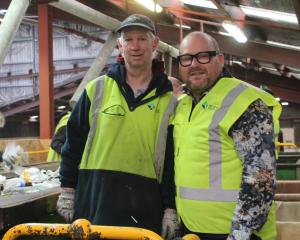Family members were waiting excitedly at the gates to greet a group of people returning from a three-and-a-half-month stint on Macquarie Island, where they were involved in a $A27 million ($NZ33.8 million) pest eradication project.
John Oakes, from Herbert-based Central South Island Helicopters, who has become well known for his expertise in aerial pest control, led the eight-strong group of pilots, ground crew and engineers.
Mr Oakes was only back in Otago briefly - heading virtually straight to Dunedin Airport to fly to Hobart to complete paperwork and attend a debriefing, before hopefully getting home by the weekend.
Aurora Australis, on lease to the Royal Australian Navy, responded to an emergency call from the New Zealand fishing vessel Janas, which had had an engine breakdown while fishing about 965km south of New Zealand.
It towed the disabled vessel to the Auckland Islands and the decision was made to continue to Port Chalmers, with a cargo that included four helicopters.
Arriving on a sunny, calm, winter's day in Dunedin was a far cry from what the group has been experiencing on Macquarie Island, an isolated and rugged subantarctic island about halfway between Australia and the Antarctic.
The island, which is 34km long and 5km wide, is a Tasmanian State Reserve, managed by the Tasmanian Parks and Wildlife Service.
Macquarie Island is about 1500km southeast of Tasmania and is home to such wildlife as elephant seals, king and gentoo penguins, and giant petrels.
Rabbits and rodents on the island have had devastating effects on native fauna, flora, geomorphology and natural landscape values.
An ambitious aerial baiting programme began last year, with the aim of eradicating rats, mice and rabbits from the island, but bad weather brought a halt to the first phase of the programme last July. Operations resumed in May this year and it was believed to be the biggest eradication programme ever tackled for three species.
It was funded by the Australian Federal Government and the Tasmanian Government, and controlled by the Tasmanian Parks and Wildlife Service.
Weather opportunities were better than last year and the team worked hard, notching up just under 500 hours of flying in four Australian-owned helicopters. The island's usual population of about 18 swelled to about 40 during the project. That included a contingent of Department of Conservation staff from New Zealand.
The weather was "unbelievably changeable", moving from "OK to atrocious" and the pilots flew often in temperatures about -5degC. They also often faced severe turbulence, Mr Oakes said.
The damage caused by "hundreds of thousands" of pests was "horrific" and the eradication project had attracted widespread interest. "The whole world was watching us," he said.
Teams would remain for the next few years doing the mop-up work, including dog handlers and hunters getting rid of the last of the rabbits. Rabbit calicivirus in January knocked back the rabbit population.
Mr Oakes was looking forward to getting home and getting back into his company's core business.












